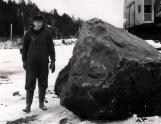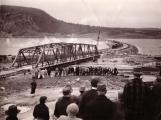39
POWERFUL TIDAL WATERS SWEPT BOULDERS DOWN THE STRAIT - As the Causeway stretched farther and farther from the mainland shore, the powerful tidal waters of the Strait were forced through an ever shrinking gap. The force of this flow was enough to affect the silt at the bottom of the Strait, making the water much deeper. Resident engineer for O.J. McCulloch Consulting Engineers Ltd., Harry MacKenzie, explained, years later, how this caused the tonnage estimates for rock to be off. "The increase over the original estimate was due to the fact that as the fill approached the Cape Breton Island side, the increased current through the narrowing aperture had washed all the overburden off the bedrock with the result that instead of there being 187 feet of water, as shown from the original soundings, it was now 218 feet."This picture, looking south, shows just how strong that current was. Taken on Dec. 10, 1954, just hours before the gap was closed, the noticeably higher water on the north side is being forced through the narrow opening. The men on the left stand on Balhache Point; just behind them would be the position of the original lighthouse. The edge of a bulldozer blade is visible in the upper-right, prepared to push in the boulders to close the gap.
Canal construction workers Sam Embree and Robert A. Fox recall just how strong the tidal current between the Causeway and Balhache Point became.
"The last ship went north about 12 hours before the Causeway was closed," Embree says. "She was going up a hill, the tide was 6 feet higher on
one side than it was on the other side."
"I saw them different times trying to get through there when the tide was running full, when it was narrowing in," says Fox. "They'd get right out there and it would stop them. They'd have to back out and wait for the tide to change."
40
Five of the workmen for T.C. Gorman Ltd. who were the first across10 December 1954
Canso Causeway work site

41
FIRST CONTACT WITH CAPE BRETON ISLAND SHORE - On December 10th,1954, the approximate ten million two hundred thousand ton Canso Causeway made contact with Cape Breton Island. Five canal project workers were the first to cross from Cape Breton Island to mainland Nova Scotia,scrambling across on a large boulder to a waiting group of Causeway construction workers.
Joe Larter, the first across and Lennan MacDonald, the second, close on his heels, recall that day:
INTERVIEWER: I understand that both of you gentlemen were among the first people to go across...
LENNAN MACDONALD: Joe was the first fellow to step across, I was number two... who was number three Joe?
JOE LARTER: Tom Wendelbo
MACDONALD: Was it Tom? I thought it was Cluett Pyke
LARTER: Nope, Tom Wendelbo
INTERVIEWER: We have a picture here, it's from the Cape Breton Post the day after...
MACDONALD: I have my baseball jacket on and you can just see my arm there.
LARTER: I'm in a leather jacket. That's me there, and you there, and there's poor old Wendelbo.
INTERVIEWER: What time did that take place?
MACDONALD: What time was it, Joe, about 8:00 in the evening? Was it that late? It was getting near dark.
LARTER: Between 7 and 8, when we were coming off shift.
MACDONALD: We came off shift and we waited and they kept dumping truckloads, you know,... and the rock just kept disappearing, disappearing, disappearing. But did the tide go down too Joe?
LARTER: No. But you see, that rock came over, I found out from the super at Northern, 65 ton. If you've ever seen a rock floating, that was floating. Gone. We went over, how did we get back? Do you remember?"
The other two men were Paul DeYoung,and Dave MacMaster.
44
In 1980, at the time of the 25th Anniversary of the Official Opening of the Canso Causeway, resident engineer for O.J. McCulloch Limited for the construction of the Canso Causeway and Canal, Harry MacKenzie, wrote the following on the inside cover of the Souvenir booklet ."My sincerest compliments to Annabelle "Tinker" MacDonald, the handsomest, most efficient secretary I ever had, my right arm during the construction of the Canso Causeway.
She calculated every ton of the 10,092,069 tons of rock it took to make the deepest Causeway in the world (218 feet) which in turn made the best and deepest ice free port in the world.
She earned the honor to be the first woman passenger along with E.O. Harling, E. Doane and myself to ride across in the first ever car to make crossing between Cape Breton and mainland Nova Scotia on Dec.11,1954 only 12 hours after completion at 8:30 pm. Dec.10th, 1954."
H. MacKenzie
Resident Engineer
46
RIP RAP NECESSARY - Sam Embree of Port Hawkesbury standing beside one of the large rocks that might be used for rip rapping the Canso Causeway for protection.There is some concern that the Causeway is particularly vulnerable after fifty years. Unlike the Canal which has received significant repairs and upgrades, the Causeway has only been repaved and been repaired when damage occurs.






